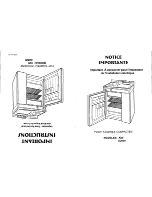
SUMMIT APPLIANCE
Page 4
IMPORTANT SAFETY INFORMATION
READ ALL INSTRUCTIONS BEFORE USING
Before You Throw Away
Your Old Refrigerator:
•
Take off the drawers so that
children may not easily
climb inside
•
For the sake of environ-
mental protection be careful
not to damage the rear wall
of the appliance (the con-
denser unit or the tubes
when moving the refrigera-
tor) or any part of the refrig-
erating system inside the
appliance.
REFRIGERANTS
All refrigeration products con-
tain refrigerants, which under
federal law must be removed
prior to product disposal.
NOTE: Contact your appliance
retailers or your local town for
information on safely and legally
disposing of old appliances.
CHOOSING THE RIGHT
PLACE
Place the appliance in a dry and regu-
larly ventilated room. Allowed ambient
temperature depends on the model
(class) of the appliance and is stated
on the rating plate of the appliance.
This appliance is class N.
CLASS AMBIENT TEMPERATURE
SN
(sub-normal) from + 56ºF to + 90ºF
N
(normal) from + 62ºF to + 90ºF
ST
(sub-tropical) from + 64ºF to +
100ºF
T
(tropical) from + 64ºF to + 120ºF
The appliance may be exposed to the
lower or higher temperature but only
for a short period of time and the
temperature should never be lower
than 41ºF. Never place the appliance
near heat emitting devices (e.g.
cooker, radiator, water heater or similar
devices) and do not expose it to direct
sunlight.
DO NOT USE AN
EXTENSION CORD
Because of potential safety haz-
ards under certain conditions, we
strongly recommend that if you
only have a two prong outlet
have it replaced by a qualified
technician with an outlet that
meets the local codes. Required
nominal voltage and frequency
are indicated on the rating plate.
The connection to the power
supply and grounding has to be
made according to the current
standards and regulations. The
appliance resists temporary volt-
age tolerance from –15 to 10%.
Your SP6DS is only for use with
110 to 120 volts and 60 cycles
(standard in USA).
FOR SERVICE CALL 1.718.328.8700
Page 7
Care and Cleaning of the Refrigerator
Cleaning the Outside
Disconnect the power supply
before cleaning the appliance.
Do not use coarse or aggressive
cleaning agents as you can dam-
age the surface .
•
Clean the exterior with a
cloth dampened with soapy
water. Dry with a soft cloth
•
Remove detachable drawers;
clean them with water and a
mild liquid detergent. Wash
the interior of the appliance
with lukewarm water, mix
one or two spoonfuls of vine-
gar.
•
Attach the drawers once air
dried.
•
Every now and then wipe the
condenser on the rear wall.
Use a soft non-metal brush
or vacuum cleaner.
The stainless steel doors and han-
dles (on some models) can be
cleaned with a commercially
available stainless steel cleaner.
Do not use appliance wax or
polish on the stainless steel.
•
Do not
wipe the refrigerator
with a soiled dish cloth or wet
towel. These may leave a resi-
due that can erode the paint.
•
Do not use scouring pads,
powered cleaners, bleach or
cleaners containing bleach
because these products can
scratch and weaken the paint
finish.
To help prevent odors, leave an
open box of baking soda in the
fresh food and freezer compart-
ments
Automatic Defrosting of the
Refrigerator
There is no need to defrost the
refrigerator, because the ice de-
posited on the inner back wall is
automatically defrosted.
Ice deposits on the inner back
wall during compressor opera-
tion; later on, when the com-
pressor is not operating, ice de-
frost any water and drains
through the outlet in the inner
back wall into the drain pan
situated above the compressor
where it evaporates.























